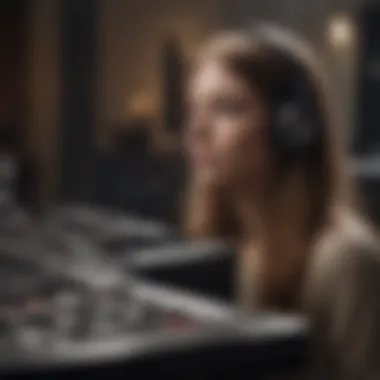The Impact of Final Cut Pro Background Music on Video Production Insights


Product Overview
Performance and User Experience
When delving into the performance and user experience aspects of Final Cut Pro, it becomes evident that the software sets a high bar for efficiency and creative flexibility in video editing. Users benefit from seamless performance benchmarks that enhance the overall editing process, allowing for smooth timeline adjustments and real-time audio synchronization. The user interface of Final Cut Pro is intelligently designed to facilitate intuitive navigation and quick access to essential editing tools, empowering creators to actualize their vision with precision and ease. Feedback from users highlights the software's robust capabilities in handling varied audio formats, enabling seamless integration of background music to evoke the desired emotional response from viewers.
Comparison with Previous Models or Competitors
In comparison with its predecessors and competitors, Final Cut Pro demonstrates notable advancements that solidify its position as a premium video editing solution. The software has continuously evolved to address user needs and technological advancements, with each iteration introducing improved performance and enhanced features for a smoother editing experience. When juxtaposed with similar products in the market, Final Cut Pro's value proposition becomes apparent through its seamless integration with Apple ecosystem devices and unparalleled rendering speeds, setting it apart as a preferred choice for professional video editors seeking efficiency and high-quality output.
Tips and Tricks
For users looking to maximize their utilization of Final Cut Pro's features, a range of tips and tricks can enhance their editing workflow and optimize performance. How-to guides and tutorials offer valuable insights into leveraging advanced editing functionalities to enhance the impact of background music in video production. Exploring hidden features and functionalities within the software allows creators to unlock new creative possibilities and elevate the quality of their productions. Additionally, troubleshooting common issues empowers users to address technical challenges swiftly, ensuring uninterrupted editing sessions and a seamless production process.
Latest Updates and News
Staying abreast of the latest updates and news surrounding Final Cut Pro is crucial for content creators keen on harnessing the software's full potential. Recent developments in software updates introduce new features and tools that expand the creative possibilities within the application, allowing for greater customization and control over audio elements. Industry news and rumors regarding upcoming products provide valuable insights into anticipated enhancements and innovations, shaping the future landscape of video editing technology. Events and announcements from Apple serve as indicators of the company's commitment to advancing its software offerings, positioning Final Cut Pro as a leading choice for video editors seeking cutting-edge solutions in the ever-evolving digital landscape.
Understanding the Importance of Background Music
Background music plays a pivotal role in video production, serving as a powerful tool to enhance viewer engagement and narrative impact. The selection of suitable music can significantly influence the tone, atmosphere, and overall emotional resonance of a video project. Understanding the importance of background music entails delving deeper into its ability to shape the viewer's perception, evoke emotions, and create seamless transitions within the narrative flow.
Setting the Tone and Atmosphere
The role of music in evoking emotions


Music serves as a fundamental element in evoking emotions within a video. Its ability to resonate with viewers on an emotional level is unparalleled, setting the ambiance, enhancing storytelling, and eliciting specific feelings or reactions. By strategically aligning music with visual content, creators can invoke joy, sadness, tension, or excitement, amplifying the audience's connection to the video.
Impact of music tempo on viewer perception
The tempo of music plays a crucial role in influencing viewer perception and engagement. A faster tempo often conveys energy, urgency, or thrill, catering to dynamic visuals or action sequences. Conversely, slower tempos evoke a sense of calm, contemplation, or melancholy, ideal for reflective moments or poignant storytelling. By leveraging varying tempos strategically, editors can guide the audience's emotional journey throughout the video.
Enhancing Narrative Flow
Creating seamless transitions with music
Music acts as a cohesive element to create smooth transitions between scenes or sequences within a video. It helps maintain continuity, drive the story forward, and bridge gaps between disparate elements. By incorporating music to underscore thematic shifts or narrative developments, editors can ensure a cohesive viewing experience that captivates and sustains audience interest.
Building tension and suspense through sound
Sound is a potent tool for building tension and suspense, heightening the dramatic impact of key moments in a video. Through strategic sound design and music selection, editors can intensify anticipation, create impactful climaxes, and keep viewers on the edge of their seats. By manipulating sound elements, such as pacing, volume, and instrumentation, creators can craft a gripping cinematic experience that leaves a lasting impression on the audience.
Utilizing Final Cut Pro for Audio Integration
In the realm of video production, the integration of audio plays an indispensable role. Final Cut Pro, a robust software cherished by professionals globally, holds a pivotal position in the seamless incorporation of audio elements. From adding music tracks to adjusting volume levels and mixing audio, Final Cut Pro offers advanced tools and features that elevate the auditory aspect of visual content to extraordinary heights. Video editors and content creators benefit immensely from the streamlined workflow and precision control that this software provides in the realm of audio post-production. In the following sections, we will delve into the intricacies of utilizing Final Cut Pro for audio integration and unveil the transformative effects it can bestow upon the final output.
Advanced Audio Editing Features
Adding music tracks in Final Cut Pro
The function of seamlessly embedding music tracks within a video project is a cornerstone of Final Cut Pro's audio suite. Video editors can effortlessly import, manipulate, and synchronize music tracks to align with the visual narrative. This feature simplifies the creative process, offering a user-friendly interface adorned with a myriad of options for selecting and refining musical accompaniments. By integrating music tracks directly within the editing environment, Final Cut Pro streamlines the workflow and enhances productivity, enabling editors to focus on crafting a cohesive audio-visual experience.
Adjusting volume levels and mixing audio


A crucial aspect of audio integration is the ability to fine-tune volume levels and mix audio elements effectively. Final Cut Pro empowers users with precise controls to adjust audio levels, create smooth fades, and blend multiple audio tracks seamlessly. This granular control over audio modulation ensures a harmonious balance between different audio components, enhancing the overall auditory experience for viewers. By offering tools for audio refinement within a single platform, Final Cut Pro proves to be a valuable asset for achieving professional-grade sound quality in video productions.
Synchronizing Music with Visuals
Aligning music cues with on-screen actions
The synchronization of music cues with on-screen actions is a fundamental aspect of video editing that contributes profoundly to the audience's engagement. Final Cut Pro facilitates this synchronization by enabling editors to align music precisely with key moments in the visual sequence. This strategic alignment enhances the emotional impact of the visuals, creating a cohesive audio-visual synergy that captivates viewers and immerses them in the narrative. By providing tools for precise cue placement and adjustment, Final Cut Pro empowers editors to craft immersive viewing experiences that resonate with audiences.
Creating impactful sound image relationships
Another critical dimension of audio integration lies in establishing impactful relationships between sound and images. Final Cut Pro offers features that allow editors to overlay sound effects, ambient noise, or musical motifs onto specific visual elements, reinforcing the narrative structure and evoking an emotional response from the audience. By leveraging these tools, video editors can craft a harmonious blend of audio and visuals that enhances storytelling, builds tension, and amplifies the overall impact of the video production. The capability to create meaningful sound image relationships distinguishes Final Cut Pro as a comprehensive platform for elevating the auditory and visual dimensions of video content.
Choosing the Perfect Background Music
Choosing the perfect background music is a pivotal aspect in the realm of video production. The selection of music can either enhance or detract from the overall viewer experience, making it a crucial decision for content creators and video editors. By carefully assessing the genre, style, mood, and theme of the video, one can create a cohesive auditory experience that complements the visual content seamlessly. Furthermore, considerations such as pacing, emotional resonance, and thematic relevance play a significant role in choosing the ideal background music.
Understanding Genre and Style
Matching Music Genre with Video Content
Matching the music genre with the video content is a strategic step in aligning the audio with the visual elements cohesively. By selecting a genre that mirrors the tone and message of the video, creators can establish a harmonious relationship between sound and imagery. For example, pairing a dramatic scene with orchestral music or a lively montage with upbeat pop tracks can evoke specific emotions and enhance the viewing experience, thereby emphasizing the importance of genre compatibility in video production.
Considering the Mood and Theme of the Video
Considering the mood and theme of the video amplifies the impact of background music by setting the appropriate atmosphere. Whether aiming to create a sense of tension, joy, suspense, or nostalgia, the mood of the music should align with the overarching theme of the video. This alignment contributes to the audience's emotional engagement and aids in conveying the intended message effectively. By choosing music that resonates with the video's theme, creators can elevate the storytelling quality and immerse viewers in a more captivating audiovisual experience.


Licensing and Copyright Considerations
Exploring Royalty-Free Music Options
Exploring royalty-free music options offers content creators a wide array of music choices without the constraints of copyright issues. This accessibility to diverse music genres enables creators to find the perfect soundtracks without the risk of legal complications. Royalty-free music also presents cost-effective solutions for commercial projects, ensuring a seamless integration of high-quality audio without compromising budgetary constraints.
Ensuring Legal Compliance for Commercial Use
Ensuring legal compliance for commercial use is a non-negotiable aspect when selecting background music. By verifying licensing agreements and understanding copyright regulations, creators can safeguard their projects from potential legal disputes. Compliance with copyright laws not only protects the creators' intellectual property but also upholds ethical standards in the industry, fostering a culture of respect for artistic content and original creations.
Measuring Impact and Effectiveness
In this section, we delve into the critical aspect of measuring the impact and effectiveness of background music in video production. Understanding the audience's response to music is paramount in evaluating the success of a video project. By analyzing viewer engagement, content creators can gain valuable insights into how their chosen music influences emotions and perceptions. Measuring impact allows for a deeper understanding of the effectiveness of selected music and its alignment with the overall goals of the video.
Analyzing Viewer Engagement
Evaluating audience response to music
Evaluating audience response to music plays a vital role in determining the overall effectiveness of background music in video production. By studying how viewers react to different musical elements, creators can tailor their choices to evoke specific emotions and enhance storytelling. The key characteristic of evaluating audience response to music lies in its ability to establish a connection between the auditory and visual components of a video, creating a harmonious viewing experience. This approach is beneficial for this article as it emphasizes the significance of music in captivating audiences and underscores the importance of strategic music selection.
Tracking retention and reaction metrics
Tracking retention and reaction metrics contribute significantly to gauging the impact of background music on viewer engagement. By monitoring viewer behavior, such as the duration of their engagement and their reactions to specific musical cues, creators can refine their content to maximize impact. The key characteristic of tracking retention and reaction metrics is its ability to provide tangible data on how music influences audience behavior, guiding creators in enhancing the effectiveness of their productions. While advantageous for analyzing viewer engagement, this approach requires careful interpretation to ensure actionable insights are drawn.
Feedback and Iterative Improvement
Incorporating viewer feedback for adjustments
Incorporating viewer feedback for adjustments is a crucial step in refining the impact of background music on video production. By listening to audience reactions and preferences, creators can adapt their music choices to better resonate with viewers. The key characteristic of this process is its emphasis on audience-driven content refinement, allowing for a more tailored and engaging viewing experience. This approach proves beneficial for this article as it underscores the importance of audience input in optimizing the use of background music to elevate video quality.
Testing different music options for optimal results
Testing different music options for optimal results empowers creators to experiment with various musical styles and tones to determine the most effective fit for their videos. The key characteristic of this approach lies in its ability to provide comparative data on different music choices, aiding in informed decision-making. While advantageous for exploring creative possibilities, testing different music options requires thorough analysis to identify the most compelling and harmonious soundtracks for video productions.



